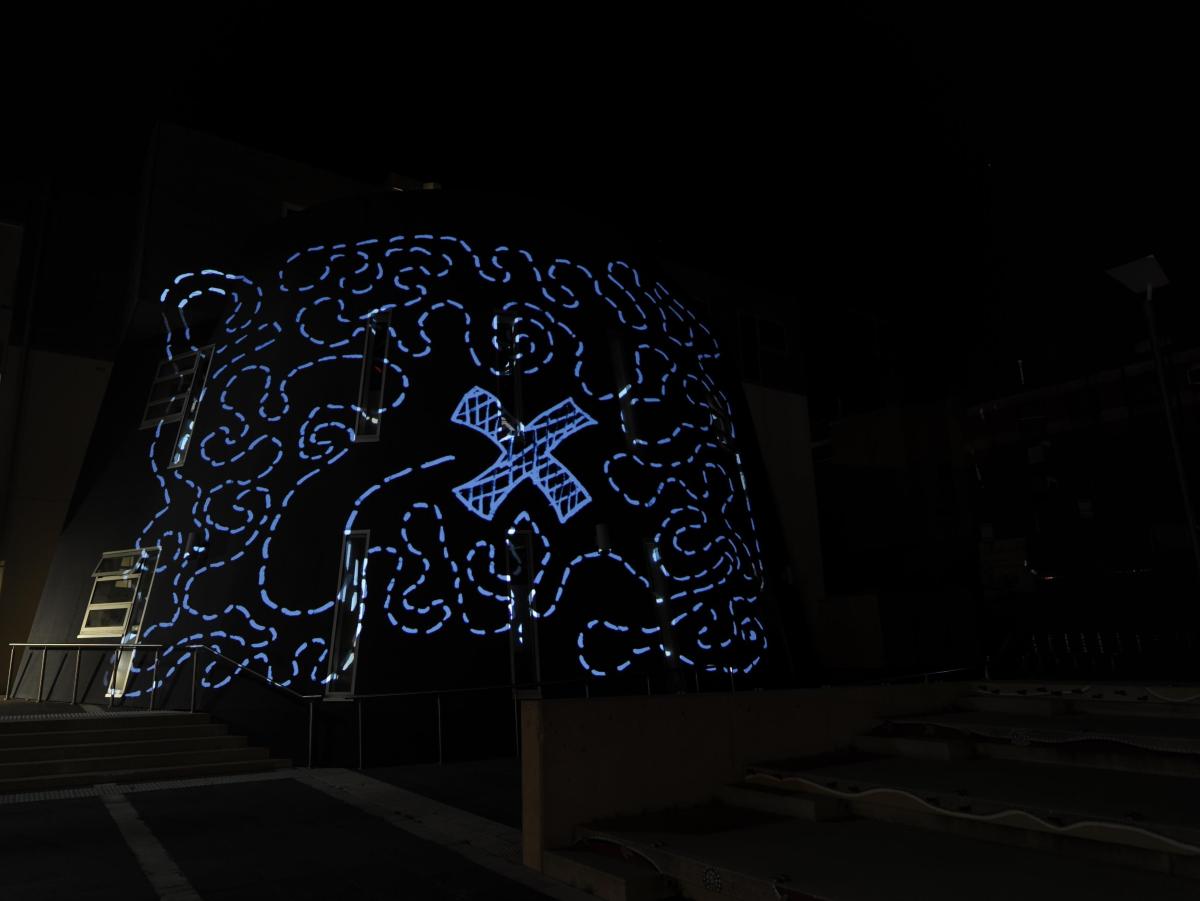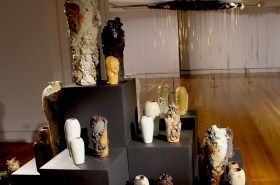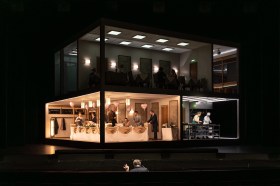Craig Walsh: Digital Odyssey, recently toured Ballarat with support from Regional Arts Victoria Photo: Digital Odyssey
If you had told the 18 year old me, bags packed and on the V/Line train to live in Melbourne forever that I would be returning to live and work in the country in my later life, I would have looked at you with horrified disbelief.
But in entering my job as Regional Arts Victoria Creative Arts Facilitator for Ballarat and the Central Highlands I have come full circle, returning to live in a regional community after 24 years training and working in Melbourne, and six years running a youth arts centre in Geelong.
Times, however, have changed and as the cultural landscape changes in regional settings, it is no longer out of the realm of possibility to live, work and create in regional Victoria.
Growing up in the 1970s in Cobram did not provide that many chances for someone interested in the arts to explore their creativity. A sleepy town located on the Murray River with a population a little over 3,000, Cobram was not exactly the epicentre of artistic activity. Anyone who had an interest in anything other than the usual cycle of football, cricket and netball needed to keep it well and truly supressed and in the closet.
Beyond the annual school musical, the only arts oasis was the occasional touring show, brought in by the local committee of the Victorian Arts Council, the 70’s precursor to Regional Arts Victoria. My first encounter with the Melbourne Symphony took place in the Cobram Civic Centre with an orchestra so big it could not fit on the stage. I remember vividly a production of Neil Simon’s Same Time Next Year, starring Peter Adams, a television celebrity best known for his starring role in the show Cop Shop. Those experiences were formative in inspiring me to want to work in the theatre.
My schooling, at that stage, was undergoing a revolution. New teaching graduates, fresh from teacher’s college and indentured to the government for two years as a condition of their scholarship, were sent to every remote outlying town in country Victoria, Their long hair and radical politics outraged the establishment and excited us as students. The culture shock for those poor young first year teachers must have been vast, I remember Wake In Fright was a popular text for English teachers during that time; I suspect they were possibly identifying a little too closely with the central character of that rather disturbing novel!
Those teachers profoundly influenced my life, and the lives of so many of my friends and contemporaries. They encouraged us in artistic pursuit, taught us drama and music and art, and pleaded for us to get out of town, out of the country and into city life as soon as we possibly could. The siren’s call of Melbourne for us was strong, and as we completed our HSC we dreamed of further education in the city and an escape from small town life. It was incomprehensible to entertain any thought but getting out of the country as soon as we possibly could.
So, thirty years on, my life turns full circle, and I find myself once more living in the country. I have taken residence in a small town of 500 people, and my work takes me to towns small and large all across Central Victoria. What, if anything, since 1982, has changed?
The Department of Planning and Community Development tells us that 1.4 million people now live in regional Victoria. The population of the Central Highlands area was 147,542 in 2006 and is expected to rise to 190,780 in 2026 and over 210,000 in 2036. Affordable housing and land is one of the key drivers for this movement, and this is a particularly relevant trend when considering the movement of artists into regional areas.
The idea of a ‘sea-change’ or ‘tree-change’ has captured the imagination of many. The popularity of living near a major regional centre and commuting to the city, or indeed starting a completely new life in the country is gaining traction. Anecdotally I have met many artists in small towns across Central Victoria who are doing just that – finding affordable regional locations to set up their home or studio, and as they move into these communities they bring with them new ideas, new art, different ways of thinking. This is not to say, however, that all new art always comes from ‘the outside’. There have been, and there continues to be many regional artists who have lived and made art in the country all their life. They have, however, mostly worked in isolation, without networks, without support, or access to professional development – “the only artist in the village”
At Regional Arts Victoria our mission is to inspire arts in all of it forms across the state – we do this through three main thrusts – inspiring Creative Communities, Creative Places, and Creative Catalysts. We are the peak body for regional artists and arts organisations, and the leading organisation for regional creative practice in Victoria.
As part of the role of supporting regional artists across the state, is the placement of Creative Arts Facilitators within communities, in partnership with regional councils. Three other people and I work across the state, based in Ballarat, Swan Hill, Port Fairy and Wellington. This role has recently undergone a name change. Some of you might be more familiar with the previous title Regional Arts Development Officer, or RADO. The change is far more than cosmetic; it is a change to more completely describe the work that we do in communities.
In a recent article for ArtsHub on creative facilitators, Creative Partnerships Manager at Regional Arts Victoria, Liz Zito stated ‘Within Regional Arts Victoria’s artistic framework, our Creative Arts Facilitators are our regional champions. Regional Arts Victoria connects communities of practice, supports the places where art is made and experienced, and fosters current and next generation creative capacity and practice. Creative Communities, Creative Places and Creative Catalysts are how we describe these aims, and our Creative Arts Facilitators are our lead Creative Catalysts across Victoria.’
Our work as a creative catalyst happens in many ways. Regional Arts Victoria administers the federal Regional Arts Fund within Victoria, and one of our roles on the ground is to work with artists within communities to develop applications to this fund. Within this region members range from individual artists seeking support to write their first funding application through to major festivals that receive state and federal money as part of their operations. The range is vast and the ideas for projects are infinite.
Our advice, though, is not just limited to funding. We support, advise, find contacts, act as a sounding board, introduce new ideas and ways of thinking and create networks. Our regional communities are home to painters, actors, musicians, writers, sculptors, costume designers and arts administrators among others. They run festivals, exhibitions, art network events, outdoor concerts and performances. As the visibility of the artists and projects rises in the community, so too does the value of this work become recognised as a cornerstone of regional life. While not yet completely out of the closet, communities have well and truly opened the door and are welcoming us out.
Regional Arts Victoria recently announced the recipients of the first grants for the Small Town Transformations initiative. An amount of funding has been awarded to five towns with populations under 1,500 – Avoca, Ouyen, Neerim South, Natimuk and Dookie, to undertake significant cultural activity to revitalise and transform their town. All five projects are currently in development, and as we watch the ideas grow we see communities coming together with a unified vision; a vision that embraces art at the very centre of this community building.
The unexpected outcomes of this project lie in fact with some of the communities who were close to achieving the grant but were ultimately unsuccessful. Rather than be discouraged, I know of two communities in this region who see the submission of the application as an invaluable visioning process for the community; that it galvanised members of the town to gather and discuss how art and cultural activity might make a difference in their town. Their visioning has not gone to waste, as they discuss and plan how their project might roll out in the future, in ways smaller, more contained, or over longer periods of time. There are regional towns that now see how art and cultural activity might contribute, not only to their quality of life, but to the very longer term survival of their community.
So what are the challenges we face in the future? We are still seeing our regional young taking that same well-worn path to the city, just as they did thirty years ago. While there are now regional learning alternatives, such as this university here in Ballarat, arts students still leave us to work in the city once they have attained their qualification. How do we keep some of them here to make new and innovative work, to tell regional stories? What opportunities do we need to provide? How do we communicate that regional arts have the same value and importance as city made projects and are not the poor country cousin? What collective resources can we offer to establish creative industries, and how do we lobby to increase our share of the funding pie? The only truly renewable and sustainable resource we can provide lies in our people, retaining great art and artists in the country, offering support and guidance, partnering with others to collaborate and share resources.
At the end of 2013, and thirty years after boarding that V/Line train, I am happy to be back working in a regional setting and proudly reclaiming my country boy identity. There is, without doubt an artistic climate in regional Victoria that did not exist thirty years ago and it is exciting to see the breadth of scope of that burgeoning in our communities. Our main resource lies in the people who have made regional Victoria their home and workplace. Let’s work together to activate even more art across the regions.





